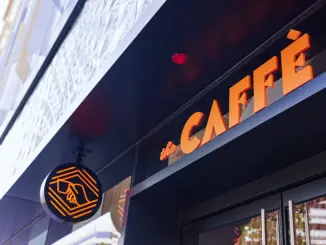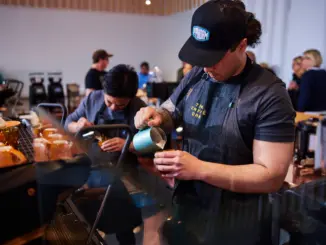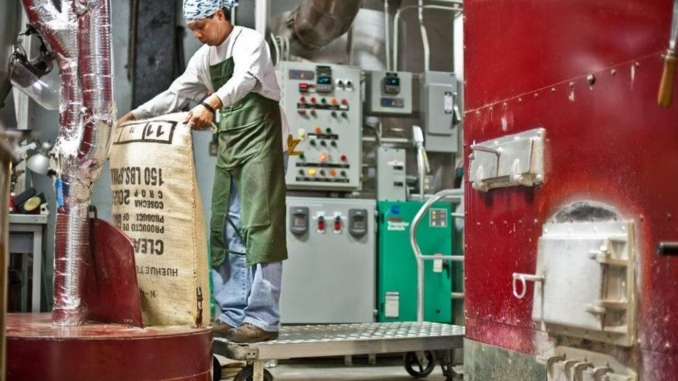
How does wood-fired roasting work? John Di Ruocco, vice president of coffee at Mr. Espresso, explains one of the most traditional methods of roasting coffee.
BY TANYA NANETTI
SENIOR ONLINE CORRESPONDENT
Photos courtesy of Mr. Espresso
Welcome to another installment of our ”Roasting Machines Explained” series! After learning about one of the most popular methods of roasting coffee, drum roasting, it’s time to take a step back in time and take a closer look at what is probably the most traditional method of roasting coffee: wood-fired roasting, or wood roasting. To find out more, I contacted John Di Ruocco, co-owner and vice president of coffee at Mr. Espresso, one of few roasters in the United States that still roasts coffee on wood.
The Origins of Mr. Espresso: A Family Affair
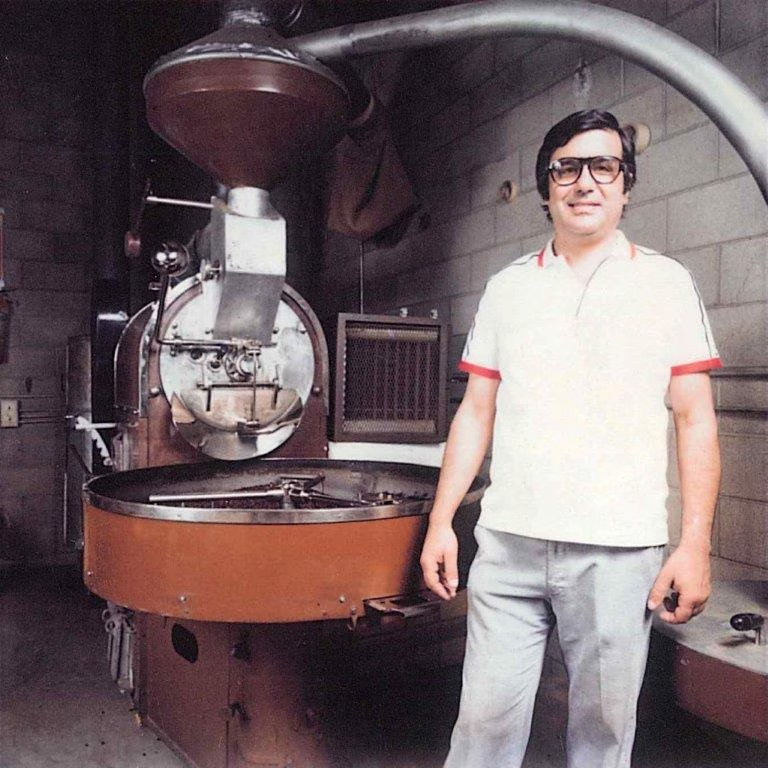
Based in Oakland and started in 1978 by Carlo Di Rucco, John’s father, Mr. Espresso owes its name to the founder’s nickname. Originally from Italy, Carlo quickly established himself as a full-service provider of wholesale coffee services to customers throughout the San Francisco Bay Area and throughout the United States, beginning by importing espresso machines from Italy.
At that time, 10-year-old John served as his father’s young apprentice, tinkering with the company’s machines and developing an avid interest in all things coffee: a passion that led him to his current path. After earning a degree in architecture from University of California, Berkeley, John returned to the family business, learning the art of wood roasting from his father and transitioning to the position of roastmaster in the early 1990s.
Wood Roasting: An Introduction
To properly introduce wood roasting (a rarity in a market where most coffee is currently roasted with gas or electric roasters), John begins by explaining a crucial difference with natural gas. “Natural gas is very dry—in fact, the moisture is removed so as not to corrode the pipes—whereas wood has a moisture content of about 15%, which is why wood provides a wetter heat source that we feel is gentler for the roasting process,“ he says. “You can roast it a little longer, resulting in a smoother, sweeter, fuller-bodied coffee.“
John goes on to explain more about Mr. Espresso’s wood roasting machine. “The machine is very similar to a gas roaster. Instead of a gas burner, we have a wood fire. We use oak wood to roast the coffee beans, which has many British thermal units (BTUs) and burns long and evenly, producing a clean (source of) heat. We’re not smoking the coffee or trying to impart a wood flavor; it’s about using a softer, moister heat source.”
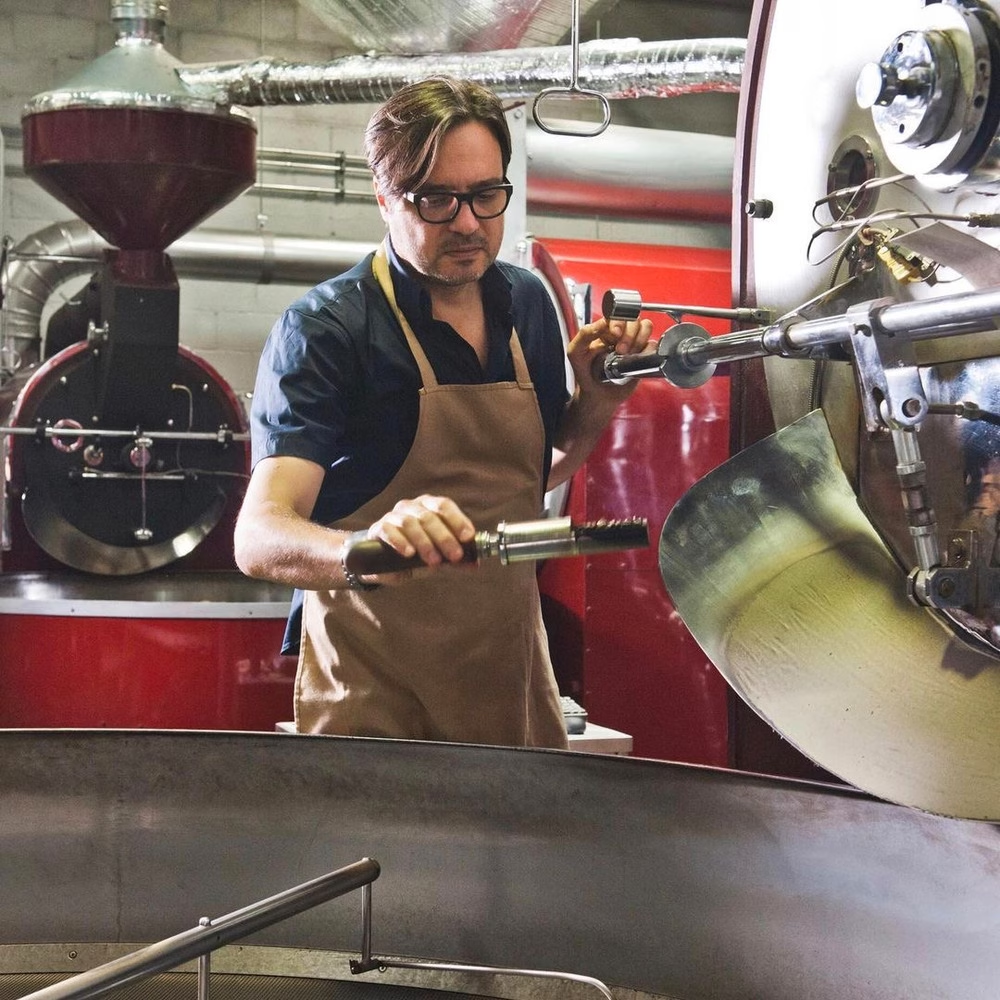
As with other roasting techniques, parameters such as airflow, drum speed, and temperature can be controlled in wood roasting, but what differs is how they are controlled. Regarding temperature control, for example, John says that with a wood-fired roaster, it isn’t as exact.
“We don’t have as precise control as with a gas roaster, but we can control the heat for the most part,“ he says. “We can control the temperature by using a system of dampers and adjusting the speed of the fan and drum. The key is to use the right amount of wood based on the size of the batch and the type of coffee, which makes the process much easier. We also use Cropsters connected to multiple thermocouples that give us accurate temperature readings at three different points on the roaster.”
Gas Roasting vs. Wood Roasting: Pros and Cons
When asked to explain the effect of wood roasting on green beans, John shares that when tasting them side by side, gas-roasted beans might taste brighter or sharper, while wood-roasted ones might taste sweeter and rounder, usually with a fuller body. “My father, Carlo, the founder of Mr. Espresso, used to say that wood-roasted coffee has a pleasant, lingering aftertaste,“ John says.
And while wood roasting can be applied to any type of bean, John and his team know that some coffees work better than others, at least for the specific roasting result they want to achieve. “We often choose coffees specifically for how they are transformed by the wood-roasting process, to always achieve sweet, round flavors with good body, which are the ideal attributes of a traditional Italian espresso,” he says.
Finally, I ask John to tell us about the pros and cons of wood roasting, to which he replies: “Although wood roasting is not necessarily a more energy-efficient process, in light of the latest news about the health risks and CO2 emissions of natural gas, we see the use of wood as an advantage. Also, the oak wood we use comes from land that is thinned for grazing in the Sierra foothills and Shasta Lake.”
Going into the specifics of the roasting experience, John adds, “The biggest advantage of wood roasting is the moisture content, while its biggest disadvantage is the steeper learning curve and difficulties in temperature control.“
He continues: “Moreover, one of the other advantages of wood roasting over conventional gas roasting lies in the quality of heat provided to the beans: Wood heat has a higher moisture content that makes it more suitable for slow roasting, reducing acidity while improving body and sweetness. The result is a coffee with more crema, a fuller flavor, and a smoother finish, characteristics essential to the classic Italian style of espresso.”
Continuing the Legacy
Lastly, John shares that wood roasting is the key reason why Mr. Espresso is renowned around the world—and that they won’t be changing their beloved wood roasting machine anytime soon.
“When my father decided to make his own coffee, he wanted to do it the same way he had learned to make it in Italy, with a wood-fired roasting machine that, at the time, was unique in the U.S.,“ he says. “And even today, as a company, we’re getting a lot of attention for that: We’re the oldest wood-fired roaster in the U.S. and probably one of the largest. Wood-fired roasting is at the heart of Mr. Espresso, and we think it produces a better and more unique product.”
Wood-fired roasting is something unique to definitely try, should you ever get a chance!
ABOUT THE AUTHOR
Tanya Nanetti (she/her) is a specialty-coffee barista, a traveler, and a dreamer. When she’s not behind the coffee machine (or visiting some hidden corner of the world), she’s busy writing for Coffee Insurrection, a website about specialty coffee that she’s creating along with her boyfriend.
Subscribe and More!
As always, you can read Barista Magazine in paper or digital format. Read the December 2024 + January 2025 issue for free with our digital edition.
And for more than three years’ worth of issues, visit our digital edition archives here.



